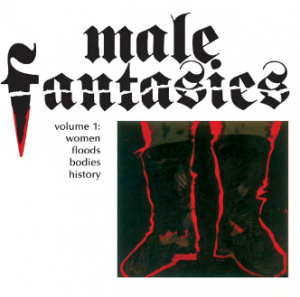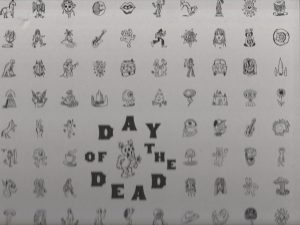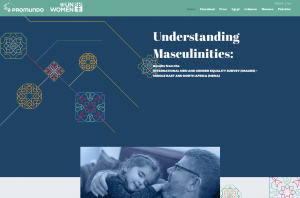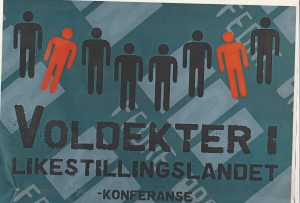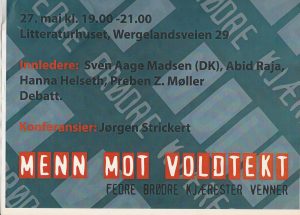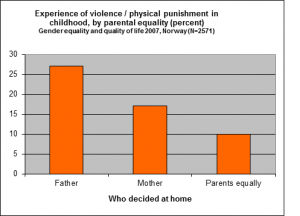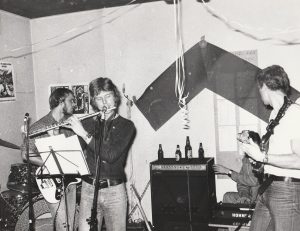
When discussing science fiction, and especially books like Heinlein’s Revolt in 2100, there is no way to get around Isaac Asimov’s Foundation trilogy. I remember, as a teenager, how it made a great impression on me. A way out, after having read Orwell’s 1984 and Huxley’s Brave new world.
(Picture: scan of the book covers, in my library)
Heinlein, like Asimov, gave a basically optimistic view of humankind – of the future – including men and masculinities. Was it naive? Is it any good, today? I remember the thrill of discovering the wide futuristic universe version of Asimov, and gradually, his greater narrative and plot. First, flight from increasing tyranny (Foundation). Second, confrontation (Foundation and empire). Third, an inner revolution (Second foundation). Rejecting empire from within. Does it still hold up? I will re-read and give a comment.
Starting here, with volume one, Foundation.
There is something utterly strange about reading these novels from 1951-52. I don’t mean all the external strangeness, carefully arranged in the books. I mean the inner strangeness, or alienation effect of reading this today, almost 70 years later.
It starts with cigars. Gentlemen, have a cigar. Preferably, a cigar “from Vega”. These gentlemen fill the scene, almost exclusively. Women are only present for illustration purposes, so to speak, in the first volume of the series. It is all about men – and a “hegemonic” competition of masculinity. There are two main types – the bully types, who use military force, and the smart types, who use religion, trade and other types of force.
There is no reflection on the absence of women. Even if the empire is said to consist of millions of worlds, with all kinds of variety of local star systems and societies, the rule seems the same everywhere – men are in, women are out. They don’t count in the big picture.
I find this amazing. It creates a kind of alienation effect (Brecht). It is unintended (not staged, like in Brecht’s plays), but that is the way it works for me, today.
Isaac Asimov creates a vast galactic empire, and a huge history, faced with breakdown, chaos and anarchy. The Foundation is created to reduce the coming age of darkness. Into this scenery, he paper-clips a report on American masculinity ca 1950.
Of course, decisions are made by men only, and of course, they smoke cigars.
These are the preconceptions that I find amazing, in an author otherwise so imaginative and coherent. Asimov is central in science fiction for good reasons.
The first volume of the series, Foundation, describes challenges met as the foundation is expelled from the central planet Trantor to the rim of the galaxy, and how it can defeat the powers surrounding it, in a period where central empire rule gradually dwindles. The heroes of the stories, placed 30 years apart, follow the “Seldon plan”, based on the science of “psychohistory”. This is not a paper clip, maybe, but a quite good approach to the optimal sociological functionalist analysis that dominated the agenda in 1950. If you can only count good enough, you will be able to predict how the future will unfold. Psychohistory is “mass” psychology, not individual psychology, Asimov underlined. He might have written “role system”. The idea was much the same. Like in Robert Heinlein’s work at the time (e g Revolt in 2100), there is a large belief in psychology and sociology.
The masculine hegemony issue is continuously referred to in the books, there is a lot of detail on how one man outperforms another, but is not reflected on “as such”, as matters between men, implying certain relationships to women and others, to “actors not present”. The silencing of this whole wider population – science fiction as masculine – was fairly typical of science fiction, one might say – at least until LeGuinn’s pathbreaking work Left hand of darkness, which put gender squarely on the agenda, and other seminal works of the 60s and 70s.
Foundation shows how men with “other” resources may win against men who use force and violence. They do this by mobilizing new resources (religion, trade) and outsmarting the bad guys. They adapt to a changing situation, the fall of the empire.
There are many positive aspects to the ethics, as I interpret it. Men of peace can win, over men of war. But there are also elements that can give me the shivers. How democratic is Asimov in this text?
The Foundation itself is described as partly democratic, although very influenced by a strong leader, who will reappear every generation in a video to give his message to his followers. The empire is ruled by an emperor, not an elected president, and does not seem very democratic, although there is a clear rule of law.
The alienation effect comes in, for example, when Asimov declares that the goal of the Foundation is to re-establish the empire. OK, this is 1950, he had not read more recent interpretations of a galactic federation or culture (LeGuinn, Banks, and many others). Is this really the goal? Should strong men, even in the “smart man” less violent version, dominate the world? Are his paper clips in fact portraits of Amerika – with a K, a binding to the Third Reich? At least, the idea of re-establishing a galactic empire with an emperor on top seems to stem more from Europe, than the US. Probably Asimov moderated and developed some of the themes I mention here,in later works, but what was actually written in 1950 is very interesting and important in its own right.
Foundation belongs to a period where gender was talked about and written about “innocently” – before the big gender challenge of the 1970s and later.
This change is easy to see in science fiction. Starting from the 1960s and attempts to renew and extend the field (e g the journal New worlds, and concepts like “inner space”), personal and gender issues became more reflected upon and problematized – especially by pioneer female authors, but also male authors.
The whole field has gradually been brought along, even though the feminist influence is sometimes superficial (women into masculine superhero types, etc.) The earlier, innocent writing on gender issues is what interests me, re-reading Asimov. It has a special charm – a way into conditions not formerly known, in 1950. Basically the empire is the idea on Asimov’s desk. The text describes how men work with such ideas.
Asimov’s men are very different from Philip K Dick’s men – for example. They represent power, not outcasts. Asimov is business-like, while Dick, writing a generation later, questions what happens, in those situations (cf The Martian Time-Slip). Dick has become a “survivor” – an author still selling to a young public – due to his problematization of power and consciousness. But it should be noted that these issues are very much on the mind of the young Asimov too, writing Foundation.
At first it may look naive, but then, the innocence gets interesting.

Robert Heinlein: Revolt in 2100 – a re-review
I have always liked science fiction. One of the first things I ever published, in a science fiction “fanzine” called Surg that I made as a youth in the 1960s, was a comparison of Huxley’s Brave new world, and Orwell’s 1984. I learned English by reading the new wave of science fiction novels that appeared in the late 1960s, and by the time I came to Le Guin’s Left hand of darkness, there was no going back. The paperbacks back then were fairly cheap even for a student, so over time I ended up with a large collection. Later, I have sifted through it, sorting out the least interesting stuff, but the collection remains ca 14 shelf meters. Sometimes, when I go back to novels I read back then, I think, well-well. Actually they still often have interesting ideas, but they don’t really work, today. These go to the “out” bin.
It is all the more a joy, therefore, to discover a novel that is still fresh and fine – or in a sense, even more so, in view of events today, including the threat of neo-authoritarian takeover of the western democracies.
Heinlein’s Revolt in 2100 pictures a future state of the USA taken over by right wing theocratic fundamentalists – working effectively through mass psychology and technology to control the population. It follows some of the same lines as The handmaid’s tale but was written twenty years before.
Heinlein does not have Atwood’s touch relating to gender, but what he does have, is interesting. It is a “young” Heinlein writing, not the “fatherly” pen of his later years. He is somewhat surprised that women can be team mates in the revolution against the tyranny – quite delightfully pictured, a true document of 1950s roles, brought a bit into the future.
There is less of the doomsday feeling than in some of Atwood’s novels. There is a real hope for democratic revolution, and the book plots this in detail. The discussion of psychological coercion and torture is impressive – and sadly, not dated at all. The masters have drones – Heinlein calls them eyes – spying on the population, and uses advanced strategies to squash all opposition.
The novel is often downright scary reading, compared to US developments today. It portrays mass indoctrination and fake news, and the emerging cult of the strong leader.
Like in Asimov’s famous Foundation trilogy, a special trick is needed to overthrow tyranny. There, it is the second foundation; here, it is the attack on the beliefs underpinning the dictatorship, before the coup is attempted.
Heinlein fans write that “he is the greatest” and I do understand what they mean. At his best – and this is frequent in this little gem of a novel – he reminds me of the great sociologist Talcott Parsons, who could be very progressive, although he was known as conservative. This is one of Heinlein’s most progressive books, and a forerunner of his most famous novel, Stranger in a strange land.
It is in parts very naive, 1950s, masculinist, and so on – but don’t let it bother you. If you have a hard day, and want to know how to overthrow tyranny – try this one.

I am re-reading Klaus Theweleit’s Male Fantasies (1977). I had it in book paper format, but someone ‘borrowed’ it, a long time ago, so my memory had grown hazy. Now it is available on the web. Re-reading is an interesting experience. Here is why this work is considered a classic in the (still small and new) field of masculinities studies.
«Male fantasies» revisited
Klaus Theweleit’s 1977 work Male fantasies is one of the classic texts of masculinity studies. This is because Theweleit focused on men and masculinities as a subject – beyond existing theories at his time, which mainly did not focus that way. Theweleit’s work was pioneering because it proposed a new research field through a dramatic example – the build-up of Nazism in Germany.
Theweleit used texts and images from the first part of the 20th century, mainly from the German soldiers and “Free corps” members after the first World War. His material documents an extreme fear of women as catalysts of change from the older patriarchal order. Reading this material, one wonders (in line with Theweleit), if the subordination of gender actually mainly went before the subordination of ‘race’, in the emerging totalitarian ideologies at the time (1920s, 30s). His material makes it likely that Nazism had large and still not fully analyzed masculine dominance underpinnings.
One main reason why this text is still often very relevant and eye-opening, is because it sticks to the phenomena, or tries to do so.
We will be examining a series of phenomena that move along the hazy border between “outright terror” and “mere convention.” Is there a true boundary separating “fascists” from “nonfascist” men?, he asks (p 27).
He finds that existing paradigms, even the critical ones, are not good enough. He discusses “latent homosexuality”, quoting Reich and Freud (p 54). Freud uses “mass commitments” (Massenbindungen) to the organizational dynamics that occur in hierarchical institutions. He notes Adorno: “Totalitarianism and homosexuality go together.” 55
Yet Theweleit critisised this type of use of Freudian concepts outside of therapy – it leads to arbitrary abstractions, he argued (p 56-57). An early perceptive argument, in hindsight. Instead he proposed a more empirical “masculinity in context” type of perspective (my term), focusing on the main phenomena in the material, regardless of existing theories.
So, as a kind of critique of simplistic theories of the authoritarian man, or even that Nazism can be reduced to latent homosexuality – here is his list of “observables”, focusing on the hazy border of what makes men fascists:
“The type of man we have before us “loves”:
—the German people, the fatherland
—the homeland soil, native village, native city
—the “greatcoat” (uniform)
—other men (comrades, superiors, subordinates)
—the troops, the parish, the community-of-blood among fellowcountrymen
—weapons, hunting, fighting
—animals (especially horses)
Aside from the animals, all of the love objects on the preceding list are ones we’ve encountered previously in connection with movements of resistance to women as potential love objects. In other words, these men claim to “love” the very things that protect them against real love-object relations!” p 61
Describing the wider mindset, especially the “Preussian” tradition among officers, he writes:
“Women have nothing to do with the “state.” A state employee is a slave, of course, but he is a slave of a man and himself a man. As such, he is closer to the state than even the wife of a general.” p 62.
Theweleit wrote before terms like “heteronormative” and “intersectional” were invented. Is he heteronormative? No. Instead he critisises heteronormative use of Freud (“latent homosexuals” as explain-away of Nazi appeal). Is his analysis intersectional? Yes clearly, if not very systematic. Postcolonial? Yes, in tendency. Imperialist ambition, social class, ethnicity, wounded pride – these are all into the picture.
His material shows that a main hate object of these men was the liberated (working class, and even communist) woman, often seen as a whore, a traitor. Democracy is whore-like. This is a main “threat factor”, engendering – so to speak – the racist and neo-imperialist ideology of Nazism.
Even if he stumbles sometimes, Theweleit does a marvelous job to exhibit the case. The return of neo-masculinism and authoritarian policies over the last decade makes his text on the masculine roots of these tendencies relevant today also. It is a pioneer work with continued importance.

Maybe, the Grateful Dead were better doing free flow improvisation like on Dark Star. Or doing country rock. Yet Terrapin station struck me hard when I first heard it, this was a serious try to summarize counterculture events, when it was released in 1977. Involving an extended orchestra, choir, rhythm section, going beyond what was formerly seen as possible. I was very impressed. The concert – it is a mini concert – never left my mind. Like what some biologists call a “meme”. Once you hear it you wont forget it. At least not, if you are a musical person. It is quite demanding. I know people who heard it but could not relate to it. Too much for them, I think..
Now, Terrapin station has been remade, in today’s climate, using today’s musicians – in very interesting ways.
I have it as part of a 10xLP box, called Day of the dead.
What is it about? The lyrics are diffuse. My short hand is “therapy”. I think this works rather well. “His job is not to master but shed light” – and so on.
Recording such a big-volume many-player piece of music is difficult. The new recording is somewhat distorted, not optimal, on the loudest parts of the music. Other tracks on the LPs in this box, with less high demand for volume, have less problems.

A recent plan at the Leeds Becket University to close down their Centre for Men’s Health has created discussion, and even a petition, among researchers. I have joined it. What is needed is a follow up of this research, not a close down.
My own research shows that there are large, but so far not so much realized health benefits for men as well as children and women in terms of gender equality. These benefits emerge as clear macro trends, as well as in survey and interview studies. Other recent studies have strengthened this picture.
Not only are the health outcomes for men more positive in gender-equal countries, with gender equality as an independent factor across e g income level and income equality. Also, the social perception of men, according to experimental psychology, is more favorable – men are seen in a more positive light, in more gender equal countries.
See Holter, Øystein Gullvåg 2014: “What’s in it for Men?”: Old Question, New Data. Men and Masculinities 17(5), 515-548; Krys, Kuba, Capaldi, Colin, et al 2017: Catching up with wonderful women: The women-are-wonderful effect is smaller in more gender egalitarian societies. International Journal of Psychology, 2017. DOI: 10.1002/ijop.12420
The petition is reproduced here:
Researchers Protest against Shutdown of
Leeds Centre for Men’s Health
It is with dismay and concern that we have learnt that it is planned to close the Centre for Men’s Health at Leeds Beckett University in August 2017. This is a huge setback not only for gender studies and critical research on men and masculinities, but for medical, sociological and psychological research as a whole. The Centre has a very high reputation on the European level and beyond.
We have collaborated in very fruitful ways with researchers in the Centre on the issues of men’s health and its connections to gender equality, violence prevention, and the enhancement of well-being for all genders. The Centre’s fantastic work on the Report “The State of Men’s Health in Europe” was ground-breaking: for the first time, data on men’s health in all European countries were analysed in a comprehensive and comparative way. Its results show the high costs that some forms of masculinity, men’s lifestyles and the lack of care bring to men themselves.
We gather that the reason for the closure is that the University seeks to restructure on economic grounds. Thus, the benefits of work of the Centre for Men’s Health, and indeed its overall social and economic value seem to be underrated. Indeed, even seen narrowly in these terms, its important work brings economic and cost savings for the wider society, the city, region and community, public services, businesses and civil society well beyond the University.
There are many good reasons to keep and develop the Centre for Men’s Health: Men’s health issues are about to become not only more recognized, but also more relevant. They are not only related to health itself, but to gender and gender (in-)equality in society (also because of the impact of men’s poor health on women and children), to social innovation and to social development. Moreover, research has revealed a need for cross-disciplinary cooperation on methodological development, for example in terms of improved health variables in other research, and vice versa, in terms of improving health variables and indexes from gender and gender equality studies.
The Centre has proved to be an excellent partner in all these discussion and areas of research. We hope that there will be ways to continue its work. We ask the representatives of Leeds Beckett University to revise their decision and help to sustain the work of the Centre for Men’s Health!
June 22, 2017
Dr. Paco Abril Morales, Girona. Dr. Gary Barker, Washington DC. Mag.a Nadja Bergmann, Vienna. Dr. Marc Gärtner, Berlin & Graz. Professor Emeritus Jeff Hearn, Ph.D., Helsinki. Professor Dr. Philos. Øystein Gullvåg Holter, Oslo. Dr. Majda Hrzeniak, Ljubljana. Dr. Ralf Puchert, Berlin. Mag.a Elli Scambor, Graz. Dr. Christian Scambor, Graz. doc. PhDr. Iva Šmídová, Ph.D, Brno.

Four news from the research front line…
1
The International men and gender equality survey (IMAGES) has recently been made in four Arabic countries (Egypt, Lebanon, Morocco, Palestine). The IMAGES survey model, developed from 2009 onwards, is partly based on the Norwegian model in the 2007 (Likestilling og livskvalitet – Gender Equality and Quality of Life) survey, adapted to international use especially in the south world, now further developed in an Arabic version. The Economist writes about the study:
The study can be found here:
2
IMAGES has developed the original Norwegian model internationally. At the same time, it has been developed in a European context.
 The first results from a Polish-Norwegian project (Gender equality and quality of life) are now published. A representative survey was made in Poland 2015, combined with qualitative research. The aim was not just to address the most pressing issues of men and masculinities (like IMAGES), but to improve the general mapping of gender in/equality in society and culture. The model was adapted to the more “gender conservative” (in some ways) context of Poland. Two books will be published from the project. Now, the “European blueprint” and “guide” have been published. This is a proposal for a European-wide follow-up study, based on the Poland/Norway testing.
The first results from a Polish-Norwegian project (Gender equality and quality of life) are now published. A representative survey was made in Poland 2015, combined with qualitative research. The aim was not just to address the most pressing issues of men and masculinities (like IMAGES), but to improve the general mapping of gender in/equality in society and culture. The model was adapted to the more “gender conservative” (in some ways) context of Poland. Two books will be published from the project. Now, the “European blueprint” and “guide” have been published. This is a proposal for a European-wide follow-up study, based on the Poland/Norway testing.
http://www.geq.socjologia.uj.edu.pl/en_GB/blueprint
The first book has just been published, describing the the project and the new research developments.

https://www.peterlang.com/view/product/25785?tab=toc&format=HC
The second book, with detailed Poland results, will be published soon.
3
Other research fields and groups are starting to pick up the results, and develop the gender equality and masculinities dimensions in their own ways. This includes an international experimental psychology study:
Krys, Kuba, Capaldi, Colin, et al 2017: Catching up with wonderful women: The women-are-wonderful effect is smaller in more gender egalitarian societies. International Journal of Psychology, 2017. DOI: 10.1002/ijop.12420
The results indicate that the perception of men is more positive in relatively gender-equal countries. In a related experimental study, the researchers find that threat and vulnerability (male role pressure) lowers men’s support for gender equality:
Natasza Kosakowska-Berezecka, Tomasz Besta, Krystyna Adamska, Michal Ja´ skiewicz, Pawel Jurek, Joseph A. Vandello 2016: If My Masculinity is Threatened I Won’t Support Gender Equality? The Role of Agentic Self-Stereotyping in Restoration of Manhood and Perception of Gender Relations. Psychology of Men & Masculinity, 17, 3, 274 –284
In another new study, in the US, researchers investigated the role of the “zero sum perspective” on gender equality – the idea that men will lose what women gain, in terms of gender equality. The results show that social dominance and sexism factors are linked to the zero sum perspective, and that men endorse this perspective more than women. Cf Joelle C. Ruthig, Andre Kehn, Bradlee W. Gamblin, Karen Vanderzanden, Kelly Jones 2017:
When Women’s Gains Equal Men’s Losses: Predicting a Zero-Sum Perspective of Gender Status. Sex Roles 76, 17-26
4
The internationally renowned masculinities researcher James Messerschmidt gave a presentation of “revised” hegemonic masculinity theory, at a well-visited seminar arranged by the Centre for Gender Research, University of Oslo, May 3, titled
Going into the theory development in depth, Messerschmidt described how it has led to a more nuanced, open view, which is complex, but also more precise than the sometimes “vulgarized” versions of the theory. This was followed by critical and constructive debate, with students as well as senior researchers participating. A summary and comment on the seminar, by professor Hanne Haavind, has been published at the center’s web site:
http://www.stk.uio.no/forskning/aktuelt/aktuelle-saker/2017/gjensyn-med-hegemonisk-maskulinitet.html

The “Men against rape” initiative
In 2006-7, there were many rape cases in Oslo. Some media called it a ‘rape wave’. I wanted to do something about this. I initiated a network and campaign, “Men against rape”. Many men signed our declaration. We got support from the Reform resource center and the Gender Equality Ombudsman.
The picture is a poster from one of our arrangements, in 2009.
The text says: “Rape in the gender-equal country – conference”.
The conference was held at Litteraturhuset, in Oslo. We also had stands and distributed leaflets in Oslo.
The campaign was clearly directed towards men. We addressed men as “fathers, brothers, partners and friends”.
We held several seminars and made interventions in our local contexts. The campaign also got media attention, e g
http://www.dagbladet.no/magasinet/2008/03/07/529076.html
http://www.dagsavisen.no/innenriks/lanserer-menn-mot-voldtekt-1.855437

For many years now, we have heard how men do this and women do that.
Men and women are different.
For example, men are more violent than women.
Only recently has research introduced gender in/equality as a control variable, regarding these proclaimed gender differences.
The results are dramatic.
Introducing the gender equality variable unsettles much of what we think we know about gender.
For example:
In the 2007 “Gender equality and quality of life” survey (in Norway), almost 2800 respondents answered questions about their childhood home. During the time of their childhood reports, the rate of violence against children generally became lower.
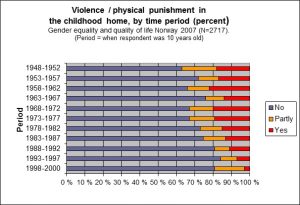 Across this period, gender equality, more than gender, influenced the chance of violence against children. “Who decided at home” (wh0 had the final say) was used as indicator of gender equality.
Across this period, gender equality, more than gender, influenced the chance of violence against children. “Who decided at home” (wh0 had the final say) was used as indicator of gender equality.
Gender inequality, even more than gender, influenced the chance of violence against children.
Father-dominated homes had almost three times the rate of violence against children, compared to gender-equal homes, in the 1940-2000 period covered by the study. Women-dominated homes were in the middle. Gender-equal homes, where the parents decided equally, had the lowest rate of violence.
Those who decided at home were also the ones most likely to use violence.
Generally, men were more often involved in the use of violence and physical punishment of children, but this varied strongly with the state of gender equality in the home. In mother-led homes, women were slightly more involved than men.
The impact of gender equality remained strong, controlling for education and other social factors.
In most of today’s research, gender equality is not used as a variable – the evidence is at best divided by gender, or it is just presented as gender-neutral.
The above example shows the need to correct that situation. By neglecting gender in/equality, research is missing the true picture.
Recently, a Poland survey has confirmed the basic pattern found in the Norway 2007 survey.
In Poland, also, lack of gender equality among the parents approximately doubles the chance of violence against children. Even if Norway and Poland are different in many respects, including different views of gender, these basic results are much the same.
Violence against children is just one area where gender equality has an impact.
Other areas, more focused in recent research, include education, health, quality of life, social perception and social stigma.

My loft is a mess. Recently I found some pictures from way back when.
In the 1970ies I was a member of the folk rock band Samvirkelaget. I also played with other groups. Here, I play flute on a student concert, 1979.
I was never that good on guitar, but could play my own songs, also.
In 1981, I published a book on the gender market (Sjekking, kjærlighet og kjønnsmarked), which sold well in Norway, and later in Sweden (1983). A press photo from that time:
In 1984, I was a participant in the Oslo carnival.
Not sure exactly what we were doing, but I remember that we were hoping to bring back more of the ‘1968 spirit’.



